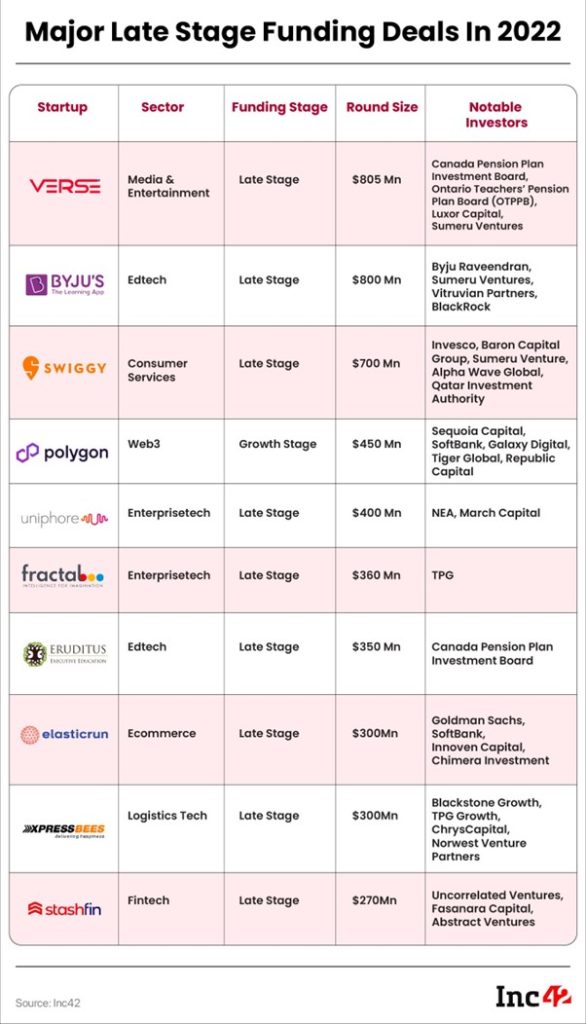What Is Late Stage Funding, And How Is It Different From Early Stage Funding?
Late stage funding is provided to companies that have progressed beyond the early stages of development, have demonstrated market traction and generated substantial revenue or user growth.
In comparison, early or seed funding is provided to startups in their early stages when they are focussed on validating their business idea and building the foundation for growth.
While late stage funding is geared towards fueling expansion, early stage funding is focussed on product development and market validation.
What Are The Typical Funding Sources For Late Stage Companies?
Typical funding sources for include institutional investors, including venture capital firms, private equity investors, angel networks and even strategic partnerships with corporate venture capital (CVC) funds.
Ideally, late stage funding happens at the Series C stage and above when startups begin witnessing rapid growth, steady revenues and expansion.
How Much Funding Is Required For A Late Stage Funding Round?
Although there are no fixed parameters, companies can secure millions of dollars in funding, depending on various factors such as their value, growth potential and investment terms. These are generally pre-IPO (initial public offering) companies or the ones looking for M&A opportunities.

What Are The Main Factors That Investors Look For?
Founder’s Track Record: Since investors take on the risk alongside founders, they seek specific qualities in entrepreneurs, including domain expertise, customer understanding and leadership abilities. The founding team’s ability to build a complementary team and execute effectively is pivotal for attracting capital at later stages of business growth.
Large TAM: VC firms also consider the market size and growth potential, favouring startups targeting large addressable markets with essential solutions and a well-differentiated product that solves real-world problems.
Risk & Rewards: Investors evaluate a company’s accomplishments, future plans, business model, legal compliance, product viability and return on investment. The investment decision is influenced by factors like the startup’s operational stage, products/services and market leadership potential — all aimed at minimising risks and maximising returns.
During turbulent times, investors prioritise resilient businesses that can withstand challenging conditions and establish long-term profitability and sustainability.
What Are The Risks Associated With It? How Can They Be Mitigated?
Late stage companies have lower risks as compared to early stage startups and offer attractive returns. However, there are still some risks involved.
Companies face the risk of inconsistent cash flow, especially during macroeconomic uncertanities. They are also vulnerable to competition and the potential loss of investment. Moreover, lack of social responsibility regarding environmental impact can decrease the value of late stage companies.
Risks Can Be Mitigated In Several Ways:
Investors can reduce risks through portfolio diversification across companies and industries. Thorough due diligence, risk assessment and monitoring are some of the most crucial factors to minimise the risks associated with late stage investing. Actively engaging with management and staying informed about best environmental, social, and governance (ESG) practices are some of the important risk mitigation strategies.
How Should A Company Prepare For A Late Stage Funding Round?
Here are some key steps to plan for a funding round:
Research your investors and understand their expectations.
Prepare a compelling pitch that highlights your unique value proposition and growth potential.
Create a well-crafted pitch that is concise, informative, and appealing.
Develop a cash flow forecast to demonstrate your financial planning.
Include a capitalisation table to show current ownership.
How To Determine If You Are Ready For It?
At this stage, companies raise funds for mostly two reasons — scaling and exits.
Scaling: Startups raise capital to expand across markets and increase revenues. Startups with a proven track record are in a position to raise late stage funding from VC funds and private equity firms.
Exit Options: Startups with an impressive track record of profits and steady growth can raise late stage funding. Investors may sell the portfolio company to another as part of an M&A (merger and acquisition) deal. Startups looking to go public (IPO) can also raise late stage funding.
What Are Some Of The Most Common Terms And Conditions Associated With Late Stage Funding Rounds?
A term sheet is a non-binding document that outlines key terms and conditions of an investment deal between a company and its investors. These terms and conditions can be around:
- Valuation: Determining the worth of the company in late stage funding rounds.
- Investment Amount: Total funding being raised and individual investor contributions.
- Liquidation Preferences: Order of repayment in case of liquidation or acquisition.
- Anti-Dilution Provisions: Protection of investor ownership if new shares are issued at a lower price.
- Board Seats and Voting Rights: Investor representation on the board and influence in decision-making.
- Exit Strategies: Agreed-upon framework for potential liquidity events like IPOs or acquisitions.
How Does It Impact A Company’s Valuation?
It can significantly impact a company’s valuation by increasing its worth, diluting existing shareholders’ ownership, providing validation and credibility, creating opportunities for growth and opening doors for potential exits.

